This article is part of an ongoing series about my Spontaneous Bilateral Patellar Tendon Rupture incident as a patient with Lupus, other chronic diseases and steroid therapy. Each part of the series will be updated and can be referenced below:
Table of Contents
Patient Profile Plays a Huge Role in Recovery Time
For a bit of background before I begin, I am a female in my 30s of Asian Chinese descent, which you can probably guess from my profile photo. I have been on prednisone for about 16 years to control Systemic Lupus Erythematosus (SLE) and Sjögren’s. I also have other autoimmune, neurological and psychological disorders, namely: Antiphospholipid Syndrome, Epilepsy (classic tonic clonic seizures), Clinical Depression & Anxiety, Paroxysmal Supraventricular Tachycardia (PSVT / Arrhythmia) and have a repaired mitral heart valve.
As you can probably guess, my situation is incomparable with another patient. Your recovery time for a Simultaneous Bilateral Patellar Tendon Rupture is going to be entirely different from mine.
The quality of my tendons are very poor, according to my surgeon. How poor as compared to yours – I obviously do not know. How steroid therapy affects me is probably different as compared to you as well, and we’re probably not a hundred percent match in physiology and ancestry. And it’s not only our genetics, but our external environment also plays a role.
TL;DR All that just to say – no two chronic illness patients are ever alike.
Disclaimer: This article is meant for educational purposes and is based on the author’s personal experiences. It is not to be substituted for medical advice. Please consult your own doctor before changing or adding any new treatment protocols.
Pin to Your Lupus, Knee Surgery & Recovery Time Boards:
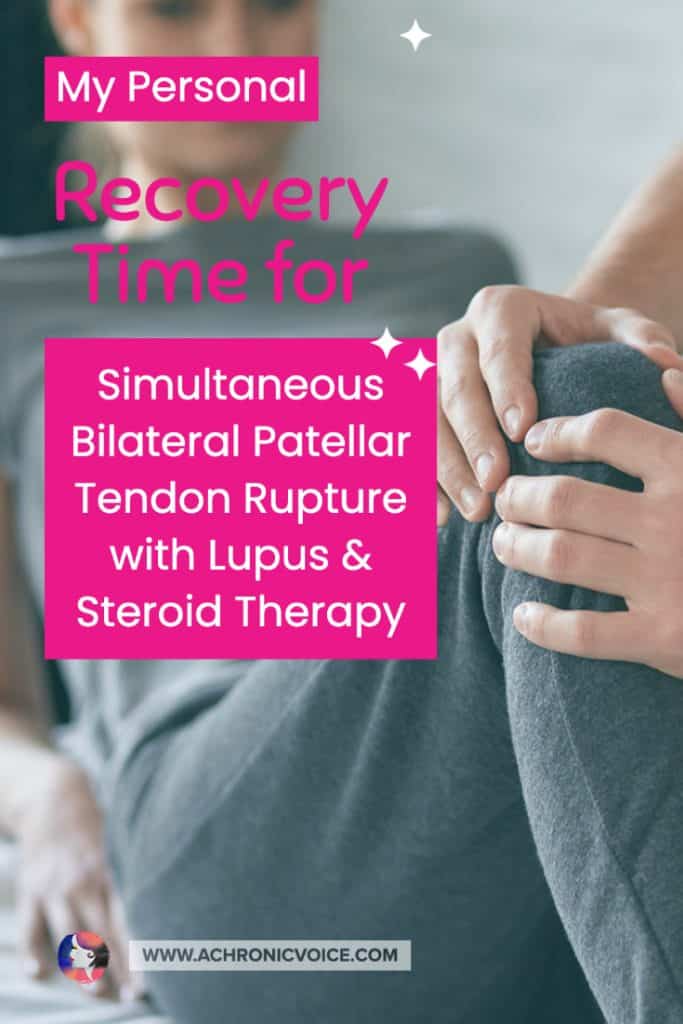
Why I’m Sharing My Simultaneous Bilateral Patellar Tendon Rupture Experience
So why bother to share my personal recovery timeline then? Well, for one I was frustrated by the lack of information out there when I was searching for answers. Such occurrences are extremely rare, so that makes sense. But that doesn’t mean that I cannot contribute my experience and knowledge as a patient in some ways.
“I was frustrated by the lack of information out there when I was searching for answers...But that doesn’t mean that I cannot contribute my experience and knowledge as a patient in some ways:” #BilateralPatellarTendonRupture #Lupus Click To TweetThere are some articles out there for patellar tendon rupture in just one knee, and mainly these are for athletes, because most of the demographic who would suffer such a violent injury are sports people. Yes, it is a violent injury; the patella tendon is the biggest and toughest tendon in the knee. It takes a great amount of force to cause a complete rupture.
Both my patella tendons ruptured simply from running – which tells you just how bad their quality is.
Pin to Your Bilateral Patellar Tendon Rupture & Chronic Illness Boards:
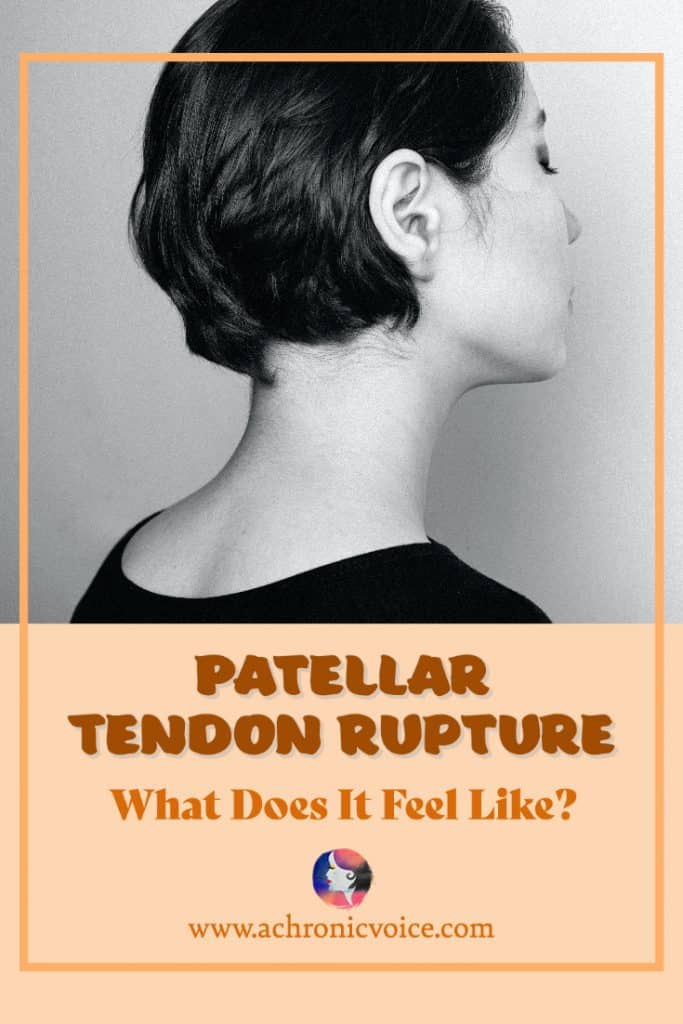
My Simultaneous Patellar Tendon Rupture Recovery Time (Ongoing – So Stay Tuned!)
30 Jan 2022: The Day the Patella Tendons Died
My life was forever changed with the sound of two successive ‘pop’ sounds.
I had been jogging beside my dog, Talisker, urging him into the curved tunnel during agility training. My body was twisted at a slight angle, but it was not like I was performing a stunt. But I guess to my Lupus and steroid eroded body, that was considered extreme sports.
I had also spent 8 hours the day before spring cleaning my room and sorting through my piles of medications. All that squatting, bending and snapping likely contributed to the ‘spontaneous’ bilateral patellar tendon ruptures too.
My knees were also strangely sore in an acute sense during agility class the week before, after doing a couple straight tunnel dashes with my dog. Running for longer distances was less painful than short spurts where I had to start and stop quickly. I guess that repeated start stop action puts a lot of strain on the knees.
You Can Never Really Tell, When Abnormal is Your Norm
I thought it was just my Sjögren’s acting up again, because my knees hurt almost every day anyway, and paid not much mind to it. I went out with a friend in the evening, and even went for a walk up and downhill despite the pains.
I had never had tendonitis or knee injuries before, so to me, it was just part of a regular Lupus or Sjögren’s pain flare. That is a huge problem with chronic, autoimmune disorders such as these. You often get so used to living with pain that you sometimes don’t notice when a pain is ‘not normal’ anymore.
“That is a huge problem with chronic, autoimmune disorders such as these. You often get so used to living with pain that you sometimes don’t notice when a pain is ‘not normal’ anymore.” #ChronicIllness #AutoimmuneDisease #Lupus Click To TweetPin to Your Chronic Illness & Chronic Pain Boards:
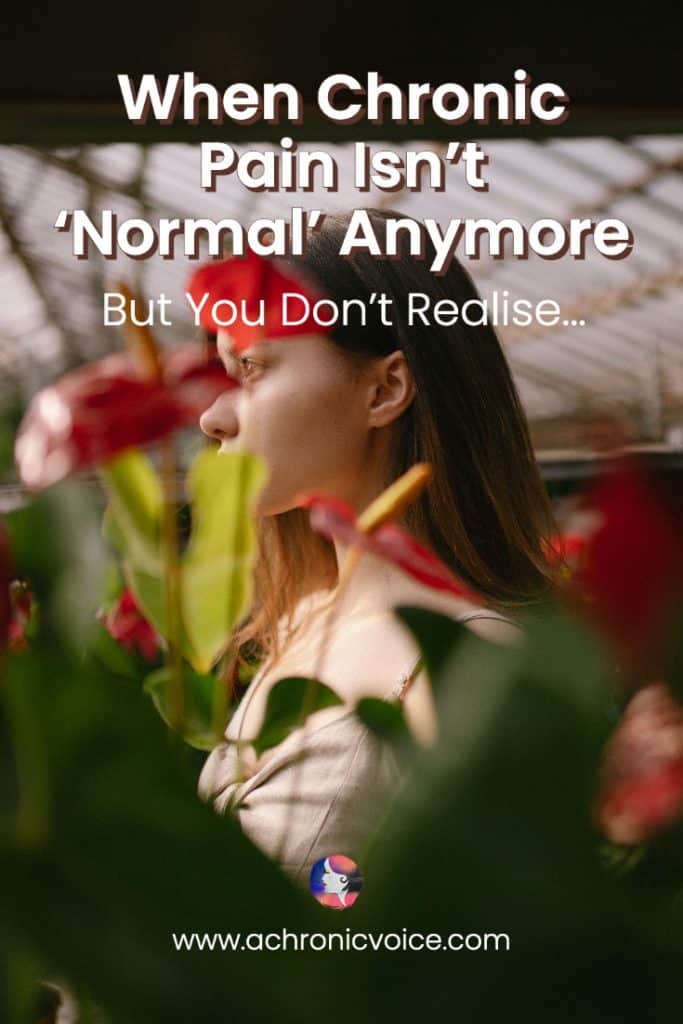
What Normal is Like for the Chronically Ill
The chronic illness life revels in drama. My screams pierced and reverberated through the wide gym area. Both dogs and humans froze in their tracks.
The trainer rushed to hold me, as I laid on my side on the grassy turf. An ambulance was called, and my parents appeared out of nowhere. For some strange reason, they had decided to visit my agility training class for the first time ever.
Initial Thoughts: Dislocated Joints & EDS Friends
I kept uttering that I had dislocated my joints under my breath. My first thoughts were of online friends who live with Ehlers-Danlos Syndrome (EDS), a disorder that makes them hypermobile.
I was already thinking of asking them for tips on how to ‘pop’ my joints back. Something that they do by themselves from time to time. That’s an irrational thought as knee joints are pretty big, but perhaps I was in denial that something worse had happened. I had never dislocated a joint before, so it was all a new mystery to me in the endless wastes of chronic pain.
Little did I know that what had happened was worse than dislocated joints. I had suffered total ruptures in both my patella tendons, which are the biggest tendons in the knees that join the bottom of the kneecap to the top of the shinbone. Without the patella tendon, you cannot bend your knee, lift your leg – or walk.
“I had suffered total ruptures in both my patella tendons, which are the biggest tendons in the knees...Without which you cannot bend your knee, lift your leg – or walk.” #PatellaTendon #ChronicIllness #DisabilityTwitter Click To Tweet
Getting to the Hospital
When the paramedics arrived, they secured my legs together with some bandages to minimise movement. They then asked me to try and straighten my legs out, so that I can be transferred to the ambulance.
I screamed, but I managed. Four of them lifted me up on a stretcher, and off I went to the nearest hospital – Sengkang General Hospital (SKH).
31 Jan 2022: The Day After the Spontaneous Bilateral Patellar Tendon Rupture Incident
The head orthopaedic surgeon at SKH saw me the following day; it was kind of a fortunate thing that he was around.
It was the long Chinese New Year holiday season, so the hospital was like a ghost town. All the patients were lying around waiting for doctors, nurses, surgeons, technicians, pharmacists, and everyone else to return to work.
Based on the x-rays and physical examinations, the surgeon concluded with certainty that I had suffered a spontaneous bilateral patellar tendon rupture. The probability of a dual rupture is next to never. Just how bad it was couldn’t be determined without cutting me open to see.
Why I Requested to be Transferred to My Regular Hospital, TTSH
The recovery time for a bilateral patellar tendon rupture is fairly long, taking up to a year. It’s also more unpredictable for a chronic illness patient like myself. Various medical teams would need to work together to provide the best possible care.
As such, I requested to be transferred to Tan Tock Seng Hospital, where my rheumatologist is. He has been my primary doctor for 20 years, right from the start of my chronic illness journey. I knew that he would take good care and advocate for me there. The orthopaedic team also seemed solid there.
31 Jan – 03 Feb 2022: Figuring Out How Bad the Injury Was & Preparing for Surgery
My case wasn’t considered an emergency, so my MRI wasn’t a priority over the holiday period. ‘Emergencies’ were supposedly for life-or-death situations only, which made me feel anxious as I had read that the sooner you operate on a patellar tendon rupture, the better the recovery rate.
As I also have Antiphospholipid Syndrome and am on blood thinners, I suffered from haematoma on top of the bilateral patellar tendon rupture. That means the swelling and edema were more pronounced. It didn’t only make my knees look more distorted physically, but all that internal pressure was painful. It felt like my knees were oranges about to burst with their juices, but not in an appetising way.
Why I Needed Stronger Painkillers as a Chronically Ill Patient
I had to keep asking for stronger painkillers, as all they wanted to give me was oral Tramadol. I am most certainly not addicted to Tramadol, but my drug tolerance for it is quite high.
It is my goto painkiller for Lupus and Sjögren’s pain flares, as I’m allergic to paracetamol (Panadol). And even though NSAIDs (e.g. Ibuprofen, Naproxen, Aspirin, etc) are actually more effective for my autoimmune disorders due to their anti-inflammatory properties, they are risky for me because of my blood clotting disorder, and the need to take blood thinning medication.
A regular person may take ibuprofen for a headache or menstrual cramp. Tramadol is my equivalent. It definitely wasn’t going to relieve pain that was higher than the regular pain I live with day to day.
“A regular person may take ibuprofen for a headache or menstrual cramp. Tramadol is my equivalent. It definitely wasn’t going to relieve pain that was higher than the regular pain I live with day to day.” #ChronicPain #InvisibleIllness Click To TweetThe Role of a Backslab for Knee Injuries
Finally, liquid morphine was administered. It helped a little, but the backslab they decided to encase my legs in was actually more effective.
A backslab is made up of bandages, and plaster which they ‘paint’ in between layers, which then dry up to form a hardened cast. This helped to contain the pressure within my knees, thus relieving some pain. It also helped to keep my knees and legs as straight as was possible, which was important to prevent further injury.
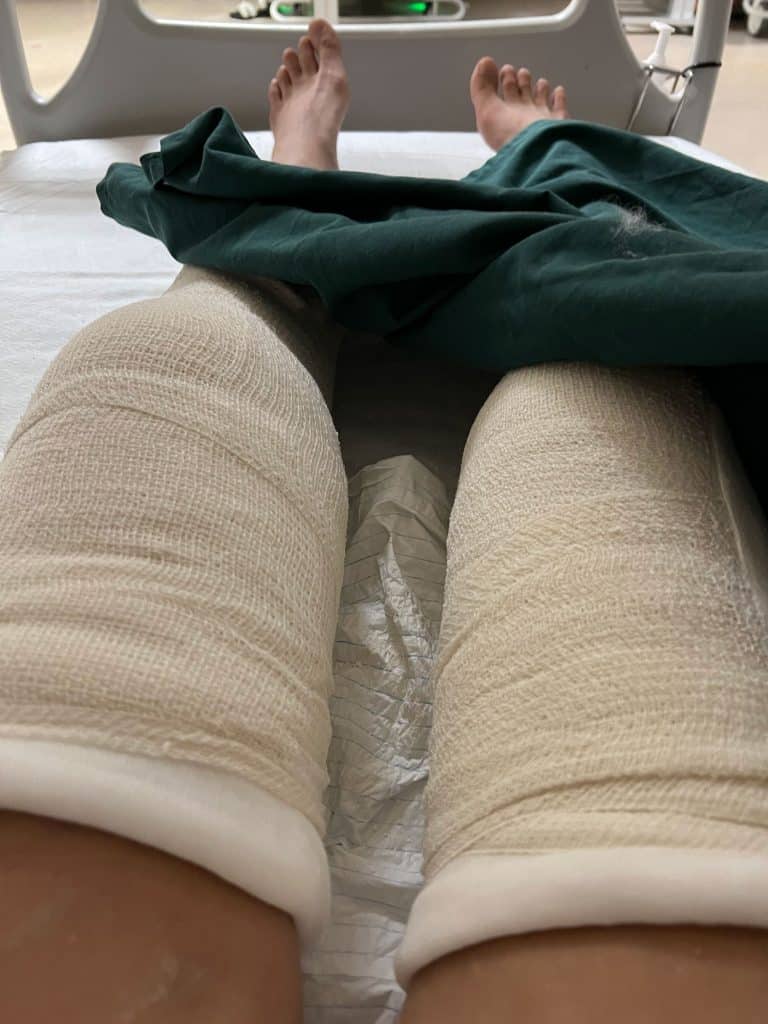
Sleep, Eat, Rinse, Repeat
As the Orthopaedic wards were full, I was parked in a random one that had a slot. A sympathetic nurse would turn on the TV for us after breakfast, and switch it off in the evening. She would select Channel 8 for us, which is the local Chinese TV channel. The ward was mostly filled with elderly Chinese women so everyone else adapted.
Apart from that we slept, washed, ate, fiddled with our phones and waited for the holidays to end. Never in my life have I wanted a festive season or long holiday period to end so quickly in my life.
The Complexity of Orthopaedics & Finding the Right Surgeon for the Surgery
Orthopaedics involves the musculoskeletal system, with each part as complex as the next. From the spine to wrist, hand, ankle, knee and more – there are specialists for each specific body part.
Dr. Farhan, Head of Foot and Ankle Surgery, paid me a visit during the holiday lull. The funny thing was that he had also paid a visit to my workplace the day before, so my boss passed along a ‘hello’. (I work at Footkaki, which is founded by one of Singapore’s first few Pedorthists selling orthopaedic footwear.)
Whilst Dr. Farhan could technically perform my surgery, I implored him to find me the best knee surgeon. Someone who was most familiar with the intricacies of the knee and tendons.
It’s a bit of an irony that surgeons who see patellar tendon ruptures the most are sports surgeons. I was nowhere near sporty. Dr. Farhan did another physical examination, and conveyed his findings to Dr. Lee, who was the Head of Department and Head of Sports Medicine and Surgery.
Dr. Lee’s biggest concern was actually the quality of my skin at the injury site. Skin infections are a major problem in knee surgeries, with the most severe complications ending in amputation. I had a small scrape on my left knee that I had acquired the day before the bilateral patellar tendon rupture, which he took note of.
The Severity of a Spontaneous Bilateral Tendon Rupture, as Surmised by a Surgeon
Dr. Lee appeared by my bedside after the holidays, much to my delight. The news was grim, and he wasn’t one to mince words. Not in an unkind manner, but as a matter of fact.
He told me that a spontaneous bilateral tendon rupture is an extremely rare and serious case. In his entire career, he had only seen five or so of such cases, and the patient profile varied widely.
The problem with tendons, unlike bones, is that they do not regrow. The best we can do is to try and repair the tendons with an allograft or autograft, which will never be as strong as they were in their original state.
I might even be disabled for life, if the surgery wasn’t successful. I was facing one of my worst nightmares – permanent physical disability.
Pin to Your Spontaneous Bilateral Patellar Tendon Rupture & Orthopaedic Boards:
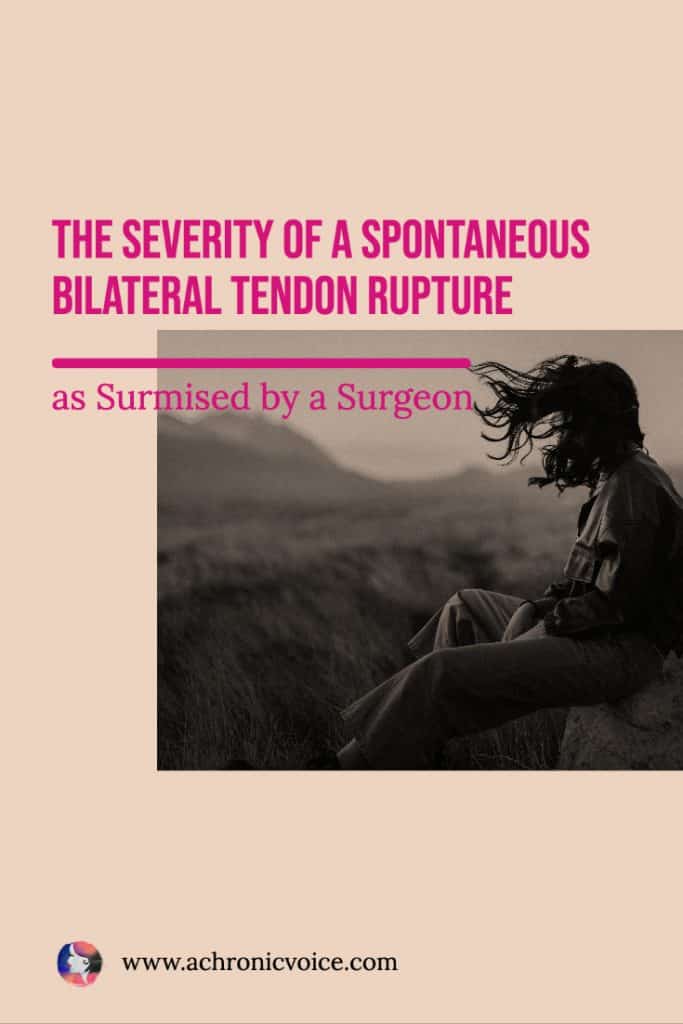
Gratitude to the Orthopaedic Team at Tan Tock Seng Hospital
Much to my relief and delight, Dr. Lee and his medical team were empathetic and understanding. He pushed for my surgery to be done as soon as was possible, even if that meant using an ER operating theatre. The Orthopaedic operating theatres were fully booked as surgeons rushed to clear the surgery backlog from the holidays.
Apparently not many Anaesthesiologists were keen to take me on as I was obviously a high risk patient. So I’m grateful that they managed to put together an excellent team, and the surgery was performed that same week.
I truly cannot praise the entire Orthopedic Department at Tan Tock Seng Hospital more. Every single doctor and medical student I met was humble, patient and humane. They truly represent what medicine is all about.
04 Feb 2022: Day of Surgery for the Spontaneous Bilateral Patellar Tendon Rupture
Preparation for Knee Surgery
As with any surgery, I had to fast the evening before. Choking whilst unconscious on an operating table would not be a great way to go. My surgery took place in the early afternoon, after Dr. Lee’s morning clinic. Fasting always leaves the patient parched, irritable and anxious, but I was just eager to get the surgery over and done with.
The porter wheeled me to the operating room, and the team started to prepare me before Dr. Lee arrived. As my veins are tiny and tricky, even the best Phlebotomists weren’t able to set a good plug in the ward for me. Anaesthesiologists are known to be experts at this, so mine was set in the surgical theatre.
The Anaesthesiologist and her assistant asked me many questions concerning my lifestyle, medical history and state of health. These are all crucial information so that they can make the best decisions on the spot should anything go wrong mid-surgery. Anaesthesiologists don’t only put you to sleep; It is their duty to ensure that you wake up, too.
The Orthopaedic team dismantled the backslab and drew arrows on my feet with a marker. A nurse helped me to pee in a bedpan, and gave me a blanket to keep warm. All standard procedures for a knee surgery.
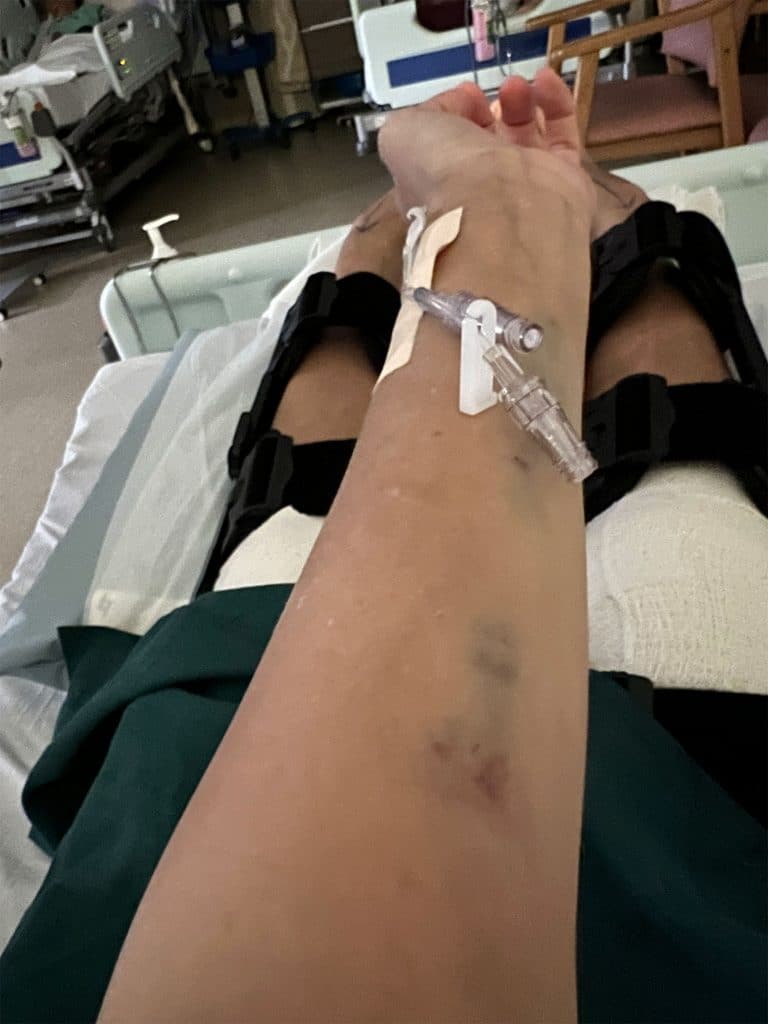
The Surgery Itself – Not Much Clue When You’re Blacked Out
Then, Dr. Lee stepped into the room. It was time. This is one of my favourite things, even though the circumstances are always dire. For some reason, I really like the feeling of becoming unconscious immediately. Maybe it’s because I rarely get a good, full night’s sleep on a regular day. With a shot into my IV line, my world turned black.
The next thing I know, I am being shook awake amidst bright lights, hustle and bustle. They asked how I was, and Dr. Lee informed me that the surgery went well. I smiled and thanked them all, even though the pain was already starting to kick in with a ferocity.
Back to the Ward We Go Post Knee Surgery
I could have some food and drink after I was wheeled back to the ward, and the team had decided that I was to be given IV fentanyl. It comes in the form of a button which you can press anytime you needed pain relief. There is an automatic lock that controls the dosage so that the patient doesn’t overdose.
As the pain was quite severe, the initial dose that they had allowed me on was insufficient. I wasn’t able to sleep from the pain, so the night shift doctor decided to give me a single shot of a higher dose.
Thank you for reading thus far. The recovery time for my Spontaneous Bilateral Patellar Tendon Rupture is ongoing, and I will report on my progress and journey as I go along for educational purposes. All links can be found at the beginning of the post 😊
If you’re suffering from this somewhere in the world too, reach out to me. I’d love to hear and share about your experiences, too. Our experiences and self-knowledge combined are, I believe, essential for progress to be made in such a rare medical occurrence.
If you liked this article, sign up for our mailing list so you don’t miss out on our latest posts! You will also receive an e-book full of uplifting messages, quotes and illustrations, as a token of appreciation!
Pin to Your Spontaneous Bilateral Tendon Rupture & Chronic Illness Boards:
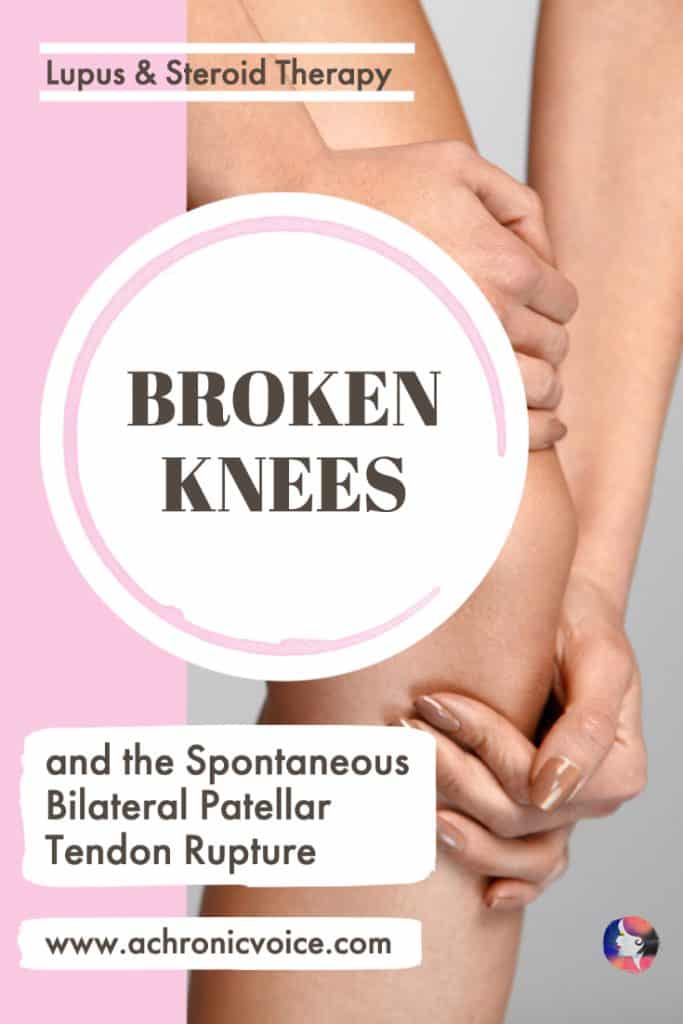
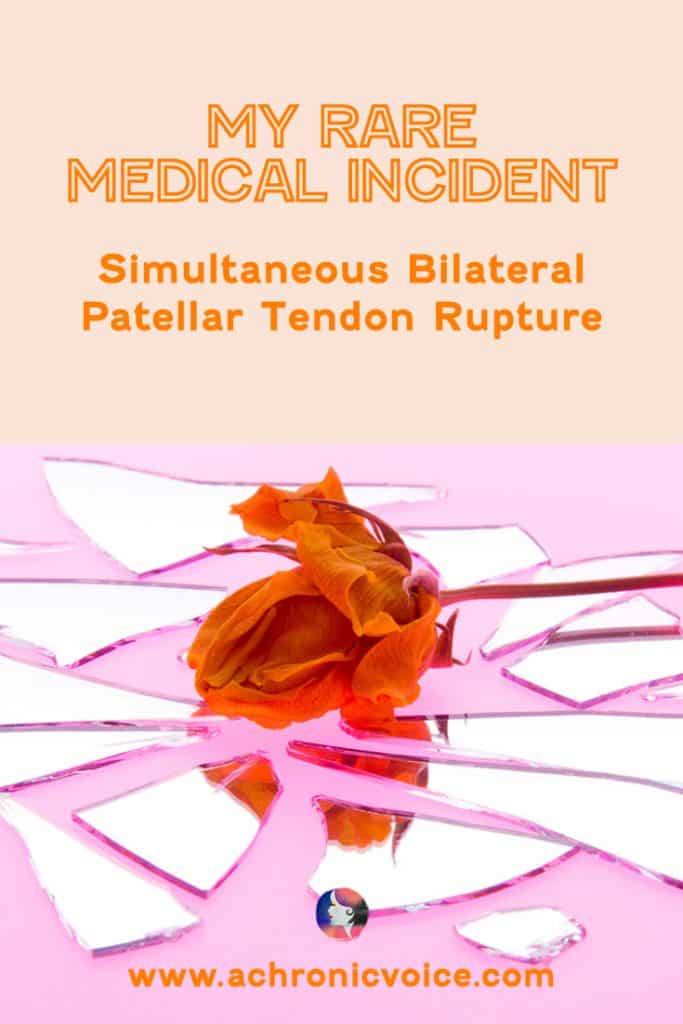
-
References:
- Rosa B, Campos P, Barros A, Karmali S, Gonçalves R. Spontaneous bilateral patellar tendon rupture: case report and review of fluoroquinolone-induced tendinopathy. Clin Case Rep. 2016 Jun 3;4(7):678-81. doi: 10.1002/ccr3.592. PMID: 27386128; PMCID: PMC4929805.
- Rosa B, Campos P, Barros A, Karmali S, Gonçalves R. Spontaneous bilateral patellar tendon rupture: case report and review of fluoroquinolone-induced tendinopathy. Clin Case Rep. 2016 Jun 3;4(7):678-81. doi: 10.1002/ccr3.592. PMID: 27386128; PMCID: PMC4929805.
- Hsu H, Siwiec RM. Patellar Tendon Rupture. [Updated 2022 Apr 30]. In: StatPearls [Internet]. Treasure Island (FL): StatPearls Publishing; 2022 Jan-. Available from: https://www.ncbi.nlm.nih.gov/books/NBK513275/
- Gunaydin C, Bilge SS. Effects of Nonsteroidal Anti-Inflammatory Drugs at the Molecular Level. Eurasian J Med. 2018 Jun;50(2):116-121. doi: 10.5152/eurasianjmed.2018.0010. Epub 2018 Jun 1. PMID: 30002579; PMCID: PMC6039135.
- InformedHealth.org [Internet]. Cologne, Germany: Institute for Quality and Efficiency in Health Care (IQWiG); 2006-. Causes and signs of edema. 2008 Nov 5 [Updated 2016 Dec 30]. Available from: https://www.ncbi.nlm.nih.gov/books/NBK279409/
- Yang G, Rothrauff BB, Tuan RS. Tendon and ligament regeneration and repair: clinical relevance and developmental paradigm. Birth Defects Res C Embryo Today. 2013 Sep;99(3):203-222. doi: 10.1002/bdrc.21041. PMID: 24078497; PMCID: PMC4041869.

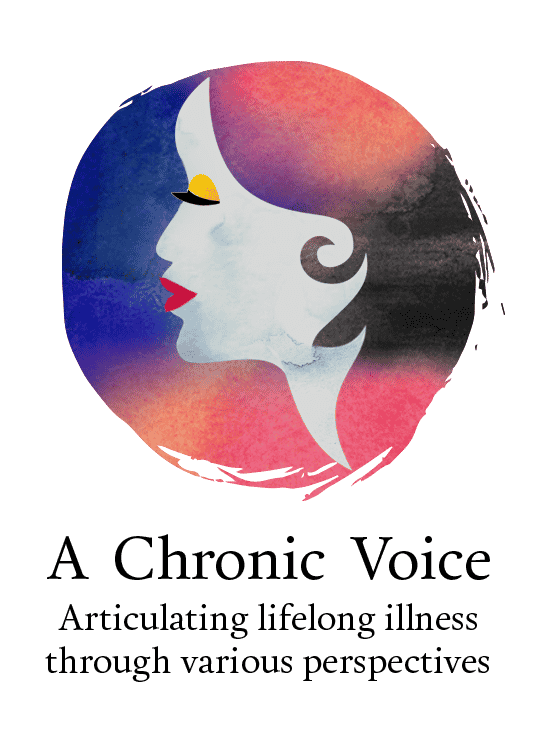

Bloody hell, you’ve been through the wringer with this, Sheryl. I’m glad you shared this, all the more so even when there’s so little information out there that pertains to a situation like yours. I actually found someone asking for anyone else with a particularly rare condition, one I’d never seen mentioned before so I couldn’t point her in the direction of anyone; searches online brought up nothing either. Blog posts on the rarer things are vitally important. It really does make a difference when the info you find is by someone who has been through similar, when it’s written on your level in some way to better apply to your situation.
“You often get so used to living with pain that you sometimes don’t notice when a pain is ‘not normal’ anymore” – very true. Or you can notice when something isn’t quite right, but so easily brush it off as ‘one of those things’ because you get so many strange symptoms and problems all the time anyway. The reality of there being a new problem isn’t one we really want to face if we can help it.
It’s quite an eye-opener on tendon and knee damage. Yikes. Thank you for sharing your experiences here and I’ll be keeping my fingers very much crossed for smoother sailing for the rest of your ongoing recuperation! xxxx
Appreciated reading this. I have Sjogren’s – mild, compared to you. My rheumatologist just told me he isn’t yet ready to out me on steroids. After reading this, don’t think I ever will! (I’m much older and not likely to really need them.) Good luck on your recovery.
Thanks Carole! Yes for me we’ve tried 10 different immunosuppressants and biologics to no effect, so I had no choice. Right now I’m having bad Sjögren’s and Lupus flares so I’ve need to increase my pred again. Otherwise, the pain is unbearable that I can’t sleep or eat. Sending love.
I am so sorry that you’re having to deal with all of that. I can only imagine how challenging it makes everything. That being said, thank you for sharing your experience and the struggles that it introduced. There are many people facing unique challenges that they need to overcome, challenges that are made more difficult by their chronic illnesses. Hearing a personal story like this can help each of us realize that we’re not alone in whatever we are going through. While our obstacles may not be exactly the same, we can all support one another and encourage those in the community to keep fighting.
Thanks Britt 🙂 Yes I hope that by sharing it helps someone else going through this very rare journey out there. And hopefully, contributes to some medical insight somehow, too!
Thank you for sharing this experience. You’re right that with such a rare situation, it is so important that info is put out there.
While I was not found to have Sjogren’s, my knees, elbows, and finger joints are really flaring (as is the dry eyes and mouth). I see my doc on the 9th. I’m going to talk to him and ask for imaging just to be sure things are okay.
Hi Katie, I really hope they find the root cause soon. Undiagnosed pain can be so despairing. Sjögren’s can often be tricky due to false negatives too. Mine was diagnosed through the eye test finally. Sending you lots of love, my dear friend.
Hi Sheryl,
Obviously you have been in my thoughts since this happened. When you posted about it, I also took some time to look up what was ahead of you and was shocked by the lack of information. I also noticed it’s all sports stuff and wondered how that would affect your treatment. Thank you for taking us through the first part of your journey and for explaining how everything led up to this event.
I hope you don’t mind questions, but did anyone ever warn you about this possibility or other possibilities given the length of time you’ve been on these meds. Has anyone advised you on what kind of activity to avoid or is it just so rare that no one thought to mention it? As patients we want to know it all, and I’m just so sad (and shocked) that this happened to you.
Not gonna lie. Seems the Year of the Tiger has been poo for both of us and I can’t wait until it’s over! I’ll continue to send good thoughts and love your way.
Hi Carrie, thank you for always keeping me in your thoughts. I appreciate it.
Yes the lack of information is sad, so am trying to contribute my little part here! A lot of the medical articles I read were more suited for sports people.
Nobody warned me about tendon ruptures, even though that’s a possibility. I guess because it’s very rare, as you can see. I guess we were also more focussed on osteoporosis, joint pains and quality of life. It’s not possible to really tell the quality of your tendons with any medical diagnosis, I think.
Yes it’s a pretty bad year for us Tigers, isn’t it?! Let’s hope, once again, it gets better.